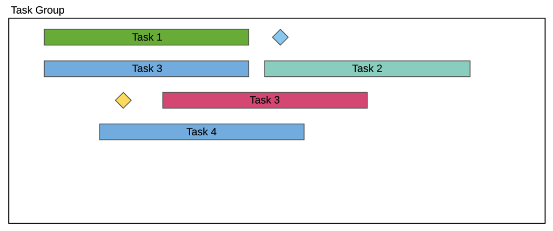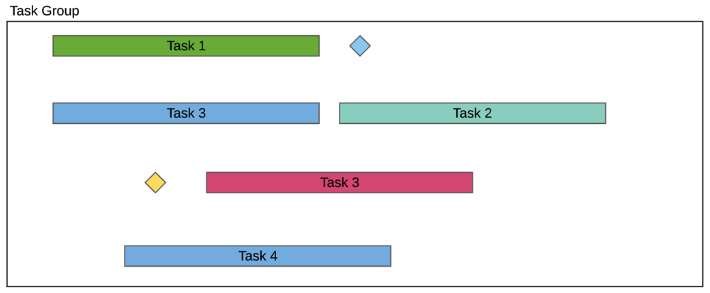Tutorials
Get started with OP3
MaxFit Distribution Algorithm
Whenever you decide to import a complex project into OP3, or create a project via Table view, OP3 needs a way to place the elements in the constrained one page plan – it will try to preserve the formatting of different elements while avoiding collisions between nearby tasks and texts of nearby tasks or milestones. This algorithm is performed in several steps. In this tutorial we assume that you are importing a new project from an Excel file, which can have up to 2000 rows.
Read more about importing into OP3 here
Calculate Rows for Items for Each Task Group
After importing a project into OP3, it’s analyzed for Task Groups, tasks, milestones and inner sub task groups, leading to a tree-like representation of the imported project. First level task groups will be rendered as task groups into OP3 – a maximum of 24 task groups are currently supported for swimlane templates, so if your imported project has more than 24 task groups, only the first 24 will be shown, while others will be marked as hidden on the Table view.
Based on the total number of task groups to show on the page, they are vertically distributed for producing a consistent view. Every task, milestone or sub task group within those task groups will be tried to be placed within the bounds of vertically distributed task groups. This means that sometimes, not every task and milestone will fit within a task group.
MaxFit algorithm tries to place as many items inside a task group as possible. There are two options to achieve this:
1. All items fit in new rows
If all the tasks and milestones inside a task group can fit within the bounds of that task group if each task and milestone are placed in new rows, then the Next Row helper algorithm is applied. This places each task and milestone, in the definition order, in new rows.

2. All items don't fit in new rows
In the case where all items in a task group cannot be placed in new rows, then the MaxFit is applied. In order to include as many items is possible on the page, it orders items by end date and groups the tasks and milestones in as few rows as possible.

The grouping is made to avoid task collisions, and it can produce more rows than the supported number of rows inside a task group. In that case, only the first N rows that can fit in a task group will be rendered, as shown in the following scenario, where only 2 rows can fit in a task group, while MaxFit has produced 4 rows.

MaxFit produces 4 rows, task group can accept only 2 rows

MaxFit places only first 2 rows inside the task group
Handling Text Collisions
This looks a bit messy, right? When importing a project into OP3, this is a possible scenario where the text of tasks or milestones can overlap either with other items or with task group bounds.

In OP3, that doesn’t happen. Text can be placed in several positions around the task’s or milestone’s shape: Center, Top, Bottom, Left and Right. You can easily change the text position of an item on the board, however while importing a project, text collision is a common scenario, but you don’t have to worry as OP3 handles it automatically.
For the example above, the text of the first milestone, ‘Finalize Part 1’ doesn’t fit in the empty space on both left and right side of that milestone. That’s why it will be automatically hidden when a project is imported into OP3. The result can be seen bellow – better, right?

After the import, you can easily turn the text on and place it on a position you may find suitable.
Vertical Distribution
We have tried to think of every possible use case while importing a project (If you find a use case that we may have let slip, please let us know). One very common use case is when you import a project with just a few task groups, two or three, and there are just a few items in each task group, the result would look like this:

Looks good but it can be much better. In this case we apply vertical distribution of each row throughout the task group, in order to achieve a consistent and beautiful project plan, that would look like this:

You get all these features out of the box while importing a project into OP3, with just a single click. But MaxFit comes with two downsides:
- - It’s slow for very large projects - for example, more than 500 rows
- - The order of items is not preserved, which can lead to project’s context to be lost
Don’t worry, we know you would like to preserve the project context and item ordering. That’s why we have integrated the Align With Previous algorithm, or AWP. Learn more about it here.
